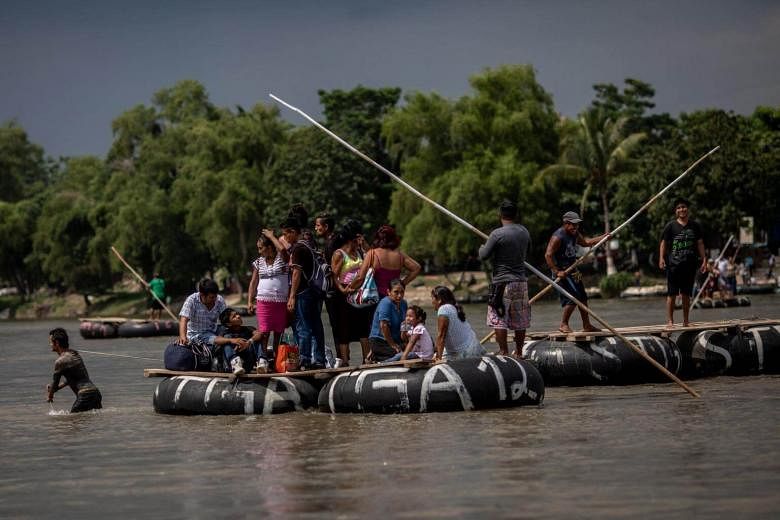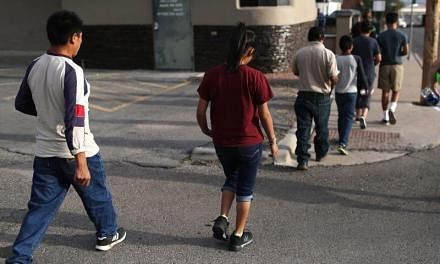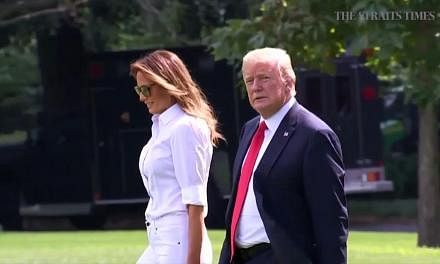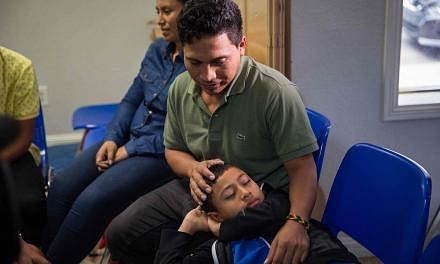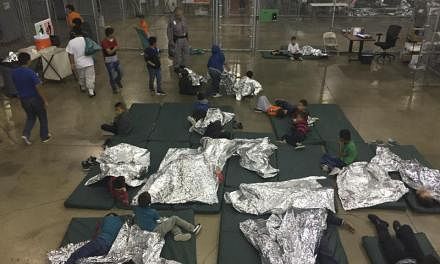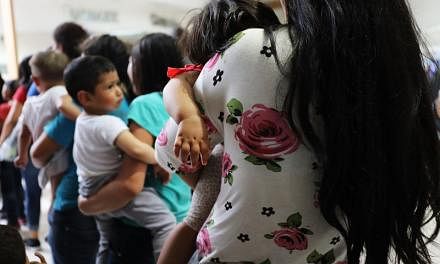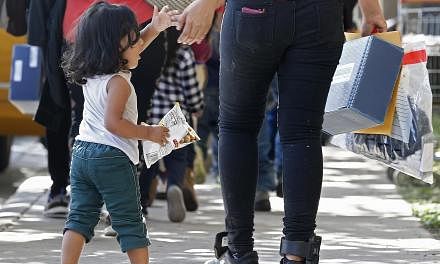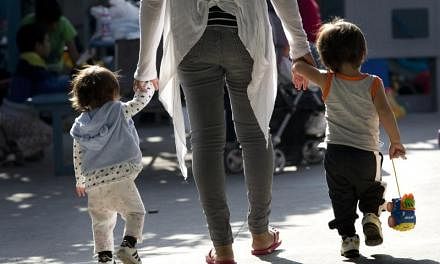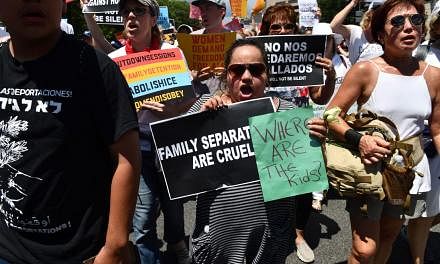TAPACHULA, MEXICO (NYTIMES) - Elid Turcios sees only dangerous - potentially disastrous - options for his family. They cannot return to Honduras, where he says gang members murdered his parents, nor do they feel safe in Mexico.
But he has heard that ahead lies the new threat that the United States will prosecute him and his wife. "My son and wife are the only thing I have," Turcios said gloomily on Wednesday (June 20).
Even so, the question is not whether to forge ahead and enter the United States, he said, but how best to do it.
"I want to get to the border," he said. "Because what else can we do?"
As the Trump administration's "zero tolerance" policy for illegal entry to the United States dominates debate in Washington and draws international attention and condemnation, it is also sowing turmoil and confusion on the long migrant trail through Central America and Mexico.
Word has spread among the migrants - by word-of-mouth, social media and the snippets of news coverage people are able to collect along the way - that the end of the road could be profoundly different for this wave than for many who went before them.
That confusion only deepened on Wednesday, when President Donald Trump signed an executive order to prevent children from being taken from their parents, though the recent, sharp increase in detention and prosecution will continue.

Lawmakers from both parties had called for an end to family separations, in the face of weeks of defiance from the president - who claimed, falsely, that it was a Democratic policy - and his aides.
In Tapachula, a southern Mexican town near the border with Guatemala, some of the people fleeing Central America said this week that the new hard line out of Washington would make them reconsider their plans, upended by US officials thousands of miles to the north.
But few saw returning to their home countries as a real option. Some planned to keep heading north, others were unsure and still others said they would just wait and see whether US policy shifted yet again.
And an increasing number of those who try to enter the United States, migrants' advocates say, will heed the siren call of human smugglers, who will argue that under the new policies, they are the migrants' best hope for getting across the border with their children.
The smugglers will even be able to increase their prices for the work as a result of the Trump administration's policy, advocates predict.
"Any restrictive measure in terms of migration and refuge is going to favor the business of the transnational criminal networks," said Ramón Márquez, director of La 72, a migrant shelter in Tenosique, Mexico.
Toasting tortillas over a fire at the Jesús El Buen Pastor del Pobre y el Migrante Shelter in Tapachula, Lucía Carmen Flores Sánchez was the rare migrant who had not heard that new policies north of the border meant prosecuting anyone making unauthorised entry to the United States, which had resulted in the separation of about 2,000 children from their parents in the past six weeks.
Many of the people fleeing Central America say they are escaping the deadly gangs there; most are from El Salvador and Honduras.
Flores, 27, who was travelling from El Salvador with her mother and her 8-year-old daughter, had planned to reunite with her father, in Baja California, and then find a way to cross with her daughter into the United States.
"Maybe better to stay in Baja California," Flores said Tuesday before Trump signed the executive order to prevent children from being taken from their parents. She cast a worried glance at her daughter. "I'm not going to lose the only thing I've got."
Some Trump administration officials have said that separating parents from children was meant to deter people from entering the United States, while other administration figures have denied it vehemently.
The administration has also said the policy was intended, in part, to stop criminals masquerading as parents from getting into the country more easily, even though only a tiny fraction of the total number of families apprehended at the southwestern border involve fraud.
Kirstjen Nielsen, the Homeland Security secretary, said this week that authorities were not separating families "legitimately seeking asylum" at a port of entry. But many families have been dissuaded from reaching those crossings and applying for asylum.
The swirl of changing standards and contradictory statements from the United States - including a recent administration decision to oppose asylum based on gang or domestic violence - have fed uncertainty among all migrants, not just those who face the harshest penalties.
"They have implemented fear," said Luis Rey García Villagrán, a migrants' advocate in Tapachula, speaking about the Trump administration. "The situation has gotten worse."
García accompanied a group of Central American families on Tuesday to apply for letters of safe passage from the Mexican immigration authorities, which would enable them to travel freely to the northern border with the United States.
There, the families planned to petition for asylum at an official port of entry, but they were unsure whether the Trump administration would prosecute them, too, as it does those who try to enter the country illegally.
They traded stories about what they had heard concerning others who had tried to cross; to some, it seemed as if different rules were enforced at different border crossings.
One man said he had heard of an official border crossing in Tijuana where a family had been allowed to remain together, but he also knew of two children from El Salvador, whose mother had been murdered by a gang, who had been taken from their grandmother at a different crossing.
Until the announcement of the zero tolerance policy, adults travelling with their minor children were generally exempted from criminal prosecutions, a policy that was well known throughout Mexico and Central America. A family that was caught entering illegally and put into deportation proceedings was likely to be released quickly to await its day in court.
"I had thought that if a mother like me had gone to the border with a child, I'd be allowed to leave detention," Flores said.
Yolanda López, 21, who was staying in the same shelter, said she fled El Salvador with her two young children after their father, a gang member, violently threatened to take them away from her. Now, she said, she was wondering whether to go through with her plan to enter the United States.
"Maybe it's best not to," she said. "What bad luck."
But many others, like Turcios, see no better alternative than to attempt an illegal entry. Much of his family fled to the United States in 2015, after, he said, his parents were murdered by a gang.
And while most of them were granted sanctuary, his asylum application was turned down and he was sent back to Honduras. Having been rejected once for asylum, he cannot apply again on the same grounds, he said.
One of the men aided by García said that he, his wife and four children had fled Honduras because of violent extortion threats by a gang, and only heard of the toughened US policy after they reached Mexico.
It was a dispiriting blow but it would not deter them, said the man, who gave only his first name, Alexander, out of fear that the gang would track him down.
Going back was not an option, he said, and remaining in Mexico was not much better. That left the United States, Alexander said, even if nobody seemed to know what would happen to them at the border.
"I'm always going to try," he said.
